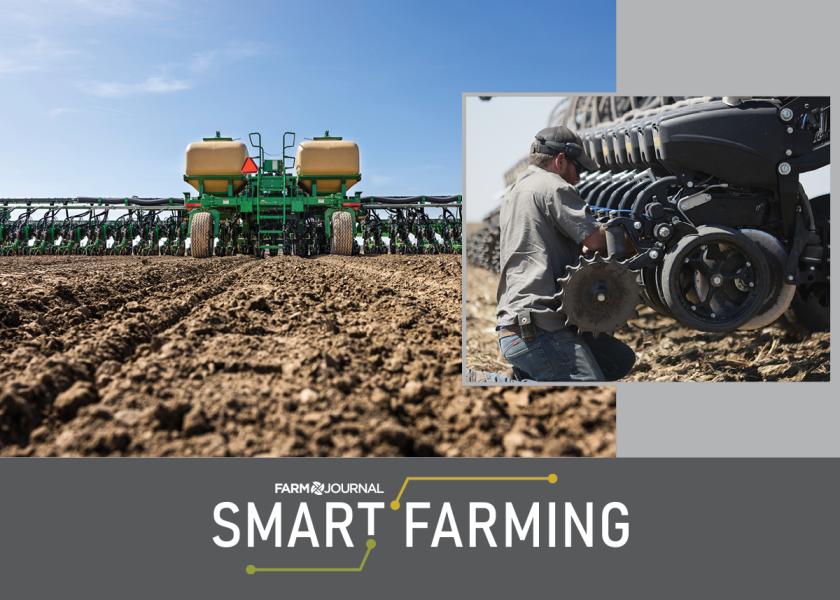Trace The Path: Spring Planter Setup Tips

Growers in Texas and Louisiana are already well into the #plant24 season. Farms in the still-warming Corn Belt will be hauling corn and soybean planters filled with fresh seed to the field in the coming days and weeks.
It’s critical that farmers have planters set up and adjusted accordingly. Downtime during the tightly needle threaded planting window can have a nasty impact on yields.
The good news is that spring planter setup is relatively straightforward, according to the experts that spoke with Farm Journal for this piece: follow the path that seed will take from tender to toolbar to the seed meter into the dirt, and leave no component left uninspected.
“Start at the hitch pin and work your way all the way through that machine, all the way to the closing wheel tail and everything in between,” says Brad Niensteadt, lead product specialist, Kinze Manufacturing. “You’re checking everything – the condition of hydraulic hoses and hitches and wiring and, you know, even something as simple as your safety chains. And do your safety lights work?”
Doug Jennings, product manager – tillage and planters, Great Plains Manufacturing, advises farmers inspect planters to gain a solid understanding of potential wear points on moving parts and components.
“Do we have the right blade contact? Do we have our coulters adjusted properly, and are all of the sensors setup and accurately sensing what’s going on with the machine,” he adds.
Precision Planting is focusing its farmer advisements for spring planting on having them check the furrow cleaning, creation and closing functions of the planter before they hit the field, according to Clay Scott, product support specialist.
“This process begins with checking planter bar levelness to make sure row cleaners don’t plow and coulters are above seeding depth,” he adds.
Meters Matter
Planter experts encourage due diligence when inspecting and calibrating the seed metering units. It’s important to have those components locked in as much as possible to begin with. The more acres the planter goes over, the more things can tend to work themselves out of alignment.
“Whether you have speed tubes or seed tubes, however the planter is set up, be sure that seed delivery mechanism isn’t damaged on the bottom,” Jennings says. “A lot of times we see those speed tubes come in contact with the blade and it creates an edge on the plastic. That causes the seed to ricochet.”
At Kinze, Niensteadt points out preliminary test stand and stationary test modes in the companies’ Blue Vantage and Blue Drive machines. Running through those modules when you have the planter in the farm shop is a wise choice, he says.
“You can choose your speed and put different hybrids in and different populations and see how that meter reacts, and make different adjustments and see how it reacts,” he adds. “That's definitely the advantage of having a higher technology machine, having that capability.”
Steady The Wheels
Once those seed meters are set, Jennings says he would move on to the closing wheels and seed firming devices, components that are essential for good seed to soil contact.
Putting on “pop-up,” or starter fertilizer at planting, is common in corn and soybean planting. Niensteadt advises growers to inspect those components closely as well.
“Are (they) worn out? Are our hose routings right, and do we have the right orifices in? Are we changing rates? All those types of things, and making sure it's cleaned out, that we get any RV antifreeze out or wherever you used to winterize it, and making sure everything works,” he says.
“It is also crucial to confirm proper gauge wheel shimming to the disc opener, inspect the seed tube guard and perform block checks to find uniform depth settings on each row unit,” Precision Planting’s Scott adds. “And the optimization of the furrow creation function involves checking for excessive wear on the depth mechanism, replacing it if needed, then running seed meters at a Precision Planting Premier dealer.”
Scott also recommends farmers perform a scratch test to “make sure the closing tail is centered over the opening system and check the closing wheels for excessive wear.”
Don’t Skip The Computer
Another consideration is going through the in-cab display in the tractor and making sure its setup in a way that works for the operator. Make sure you have the latest operating system updates downloaded and ready to go, Niensteadt says.
“More importantly, not only update it, but clean it up, too. Take out old data, add new hybrids that you're adding this year,” he says. “Maybe you got some new fields, maybe you put new boundaries in and maybe you're running new prescriptions. That prescription that you used last year for beans isn't going to be the one for this year.”
If you’re using the same tractor to pull planters in both your corn and soybean fields this spring, make sure you confirm all of the settings you need to change on the monitor when going from crop to crop, Precision Planting’s Scott adds.
“This may include changing seeds per disc, row spacing, target population or even seed exit locations in order for our drive system to swath properly,” Scott says.
Dialing up your tractor’s autosteer and making sure it’s working properly is another box to check, according to Jennings. And then once you're in the field and planting, it still pays to keep a shovel handy for boots on the ground confirmation of what’s happening out the back of that planter.
“The monitor tells us what the sensors are seeing, but there is no replacement for digging in the dirt and seeing where that seed is placed,” he adds. “Get out the cab, get down and get those knees dirty and start digging.”
Corn vs. Soybean Considerations
In years past, some farmers (not all, of course) were known to exhibit a bit of a casual attitude when it came to soybean planter calibration. The idea being that corn required precision placement for top end results, but “as long as the soybeans got there – as long as they’re in the ground, heck they can even be on top of the ground – they’re going to grow,” Niensteadt shares.
It’s an attitude that is changing, but corn remains, as they say, king.
“Look at soybeans just like corn and get them in the soil at the right depth, and with even spacing,” he says. “As we're reducing populations in soybeans, we need to maximize that seed that is in the ground to do everything it can, just as we want to maximize that corn plant.”
Jennings has also witnessed a shift in strategy when it comes to soybeans.
“When I started 25-30 years ago, we were planting beans in pounds per acre. We thought at the time they were more forgiving than corn,” he adds. “Today we’re buying and planting soybean seeds by the thousands per acre, just as we do in corn. There are differences in the metering technologies and seed disks, but uniform depth control, emergence, seed to soil contact…there is no substitution for a strong, uniform emergence.”
Follow along with spring planting progess with weekly AgWeb updates.







